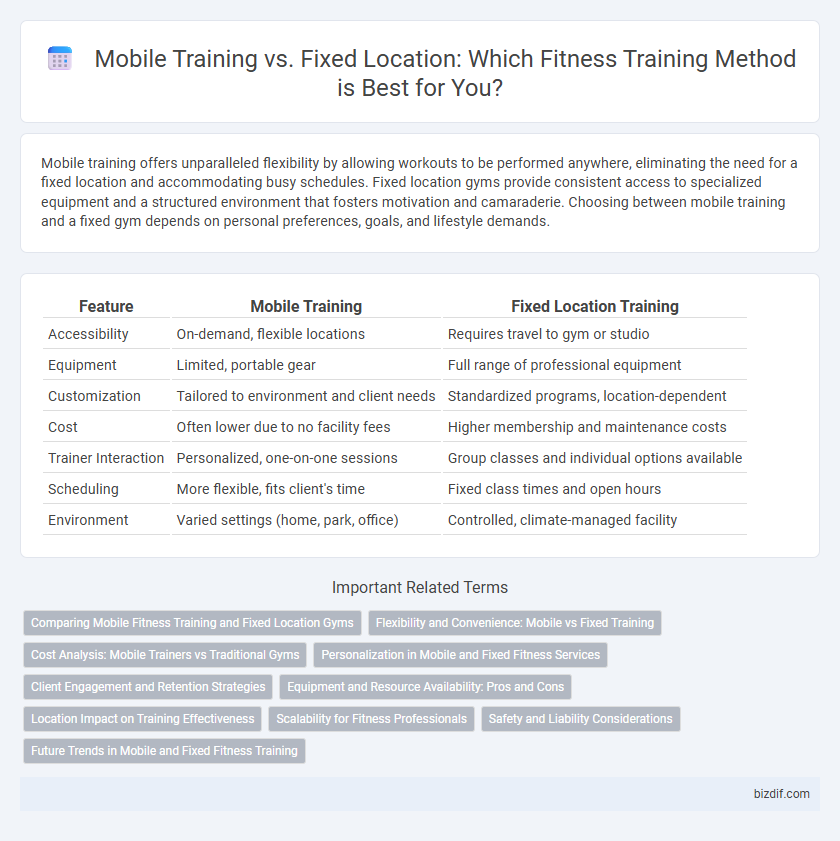Mobile training offers unparalleled flexibility by allowing workouts to be performed anywhere, eliminating the need for a fixed location and accommodating busy schedules. Fixed location gyms provide consistent access to specialized equipment and a structured environment that fosters motivation and camaraderie. Choosing between mobile training and a fixed gym depends on personal preferences, goals, and lifestyle demands.
Table of Comparison
| Feature | Mobile Training | Fixed Location Training |
|---|---|---|
| Accessibility | On-demand, flexible locations | Requires travel to gym or studio |
| Equipment | Limited, portable gear | Full range of professional equipment |
| Customization | Tailored to environment and client needs | Standardized programs, location-dependent |
| Cost | Often lower due to no facility fees | Higher membership and maintenance costs |
| Trainer Interaction | Personalized, one-on-one sessions | Group classes and individual options available |
| Scheduling | More flexible, fits client's time | Fixed class times and open hours |
| Environment | Varied settings (home, park, office) | Controlled, climate-managed facility |
Comparing Mobile Fitness Training and Fixed Location Gyms
Mobile fitness training offers personalized workouts in convenient environments, eliminating commute time and providing flexible scheduling, which enhances adherence and motivation. Fixed location gyms provide extensive equipment, group classes, and social interaction opportunities, fostering a structured environment ideal for varied training needs. Comparing both, mobile training excels in accessibility and customization while gyms deliver comprehensive facilities and community support.
Flexibility and Convenience: Mobile vs Fixed Training
Mobile training offers unparalleled flexibility by allowing workouts to occur anytime and anywhere, eliminating travel time and accommodating busy schedules. Fixed location training provides structured environments with specialized equipment and consistent access to professional trainers, enhancing workout quality and motivation. Convenience in mobile training suits individuals needing adaptable routines, whereas fixed locations benefit those seeking routine and dedicated fitness spaces.
Cost Analysis: Mobile Trainers vs Traditional Gyms
Mobile fitness training typically offers lower overhead costs compared to traditional gyms, resulting in more affordable session rates for clients. Mobile trainers save on expenses like rent, utilities, and equipment maintenance, which are factored into fixed-location gym memberships. This cost efficiency makes mobile training a competitive alternative for personalized fitness without long-term contracts or high monthly fees.
Personalization in Mobile and Fixed Fitness Services
Mobile training offers highly personalized fitness programs tailored to clients' environments, schedules, and equipment availability, enhancing adaptability and convenience. Fixed location gyms provide specialized equipment and professional oversight, enabling structured progress with customized plans based on precise assessments. Both models prioritize personalization but differ in flexibility, with mobile training emphasizing real-time adaptability and fixed locations focusing on comprehensive resource access.
Client Engagement and Retention Strategies
Mobile training boosts client engagement through personalized, flexible workouts at convenient locations, increasing consistency and motivation. Fixed location gyms excel in providing a structured environment with access to diverse equipment and community support, enhancing client retention. Combining mobile training's adaptability with fixed gyms' social atmosphere creates a comprehensive strategy to maximize long-term client loyalty and satisfaction.
Equipment and Resource Availability: Pros and Cons
Mobile training offers flexibility and convenience by delivering fitness sessions directly to clients using portable equipment like resistance bands and dumbbells, but it may lack access to specialized machines and extensive resources found in fixed location gyms. Fixed location facilities provide a comprehensive range of equipment including cardio machines, weight stacks, and functional training zones that enhance workout variety and effectiveness; however, they require clients to travel and adhere to set schedules. Resource availability in fixed gyms supports advanced programming and social motivation, while mobile training prioritizes personalized, on-the-go fitness solutions with limited equipment options.
Location Impact on Training Effectiveness
Mobile training offers flexibility by allowing workouts in diverse environments, which can enhance motivation and adaptability, while fixed location training provides consistent access to specialized equipment and structured settings that support progressive overload and precise technique improvement. The impact of location on training effectiveness depends on individual goals, with fixed locations benefiting strength and skill-focused routines, whereas mobile training suits functional fitness and varied movement patterns. Consistent environment factors, such as equipment availability and space, significantly influence adherence and performance outcomes.
Scalability for Fitness Professionals
Mobile training offers unparalleled scalability for fitness professionals by enabling them to reach a broader client base without the constraints of a fixed location. Utilizing mobile platforms and apps allows trainers to deliver personalized workouts remotely, increasing client engagement and retention across diverse geographic areas. Fixed-location gyms, while providing dedicated facilities, often limit scalability due to physical space and local market saturation.
Safety and Liability Considerations
Mobile training offers flexibility but requires thorough risk assessments to ensure safety in varying environments, minimizing liability from unpredictable surroundings. Fixed location training allows controlled conditions with established safety protocols, reducing injury risks and liability issues for trainers and clients. Both methods demand comprehensive waivers and adherence to certification standards to mitigate potential legal complications.
Future Trends in Mobile and Fixed Fitness Training
Mobile fitness training leverages advanced wearable technology and AI-driven personalized coaching to deliver highly adaptive and data-rich workouts anywhere, enhancing user engagement and convenience. Fixed location gyms are integrating hybrid models with virtual reality experiences and smart equipment to retain social interaction while offering innovative training modalities. Future trends indicate a convergence where mobile and fixed fitness solutions complement each other, driven by increased demand for flexibility and immersive, technology-enhanced exercise environments.
Mobile Training vs Fixed Location Infographic

 bizdif.com
bizdif.com